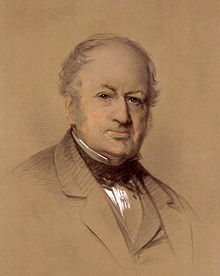Edward Blore
| Edward Blore | |
|---|---|
 |
|
| Born |
13 September 1787 Derby, England |
| Died | 4 September 1879 (aged 91) |
| Nationality | British |
| Occupation | Architect |
| Known for | Buckingham Palace; Lambeth Palace restoration |
Edward Blore (13 September 1787 – 4 September 1879) was a 19th-century (Victorian and pre-Victorian) British landscape and architectural artist, architect and antiquary.
He was born in Derby, the son of the antiquarian writer Thomas Blore.
Blore's background was in antiquarian draughtsmanship rather than architecture, in which he had no formal training. Nevertheless, he designed a large palace for Count Vorontsov in Alupka, Crimea (see 'Later career', below) and important ecclesiastical furnishings designed by him included organ cases for Winchester Cathedral and Peterborough Cathedral (the Peterborough case since removed) and the choir stalls in Westminster Abbey. Charles Locke Eastlake, writing in 1872, believed that he had been apprenticed to an engraver, but other sources dispute this. He illustrated his father's History of Rutland (1811), and over the next few years he made the drawings of York and Peterborough and measured drawings of Winchester for John Britton's English Cathedrals, and drew architectural subjects for various county histories. In around 1822 Blore supplied the illustrations to Thomas Frognall Dibdin's Aedes Althorpianæ. In 1823 he toured Northern England, making drawings for a work called the Monumental Remains of Noble and Eminent Persons. It was issued in parts with text by the Rev. Philip Bliss, and completed in 1826. Blore engraved many of the plates himself.
In 1826, he was appointed surveyor to Westminster Abbey. The following year he was engaged to furnish plans for the chancel fittings of Peterborough Cathedral. Shortly afterwards he was employed to restore Lambeth Palace, then in a state of near ruin. His work there included the construction of a fire-proof room for the preservation of manuscripts and archives.
...
Wikipedia
